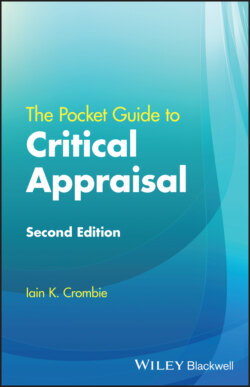Читать книгу The Pocket Guide to Critical Appraisal - Iain K. Crombie - Страница 9
ОглавлениеCHAPTER 2 Do Not Read the Paper
The most important piece of advice when appraising a scientific paper is: do not read the paper. Scientific papers are complicated, information dense, and full of technical jargon – they cannot be read like a newspaper article. They are written for experts and prioritise technical correctness over ease of understanding. The research design is often complex, and the statistical analysis sophisticated. Papers are written with the assumption that the reader is familiar with the scientific terms and the methodologies used. Reading every word from the Introduction to the Discussion may lead to confusion.
A better approach is to interrogate the paper, asking questions to make it reveal the information about study design and conduct. Unlike reading, which is a passive process, critical appraisal searches out the key pieces of information about a study. Interrogation puts the reader in charge, directing questions at different sections of the paper, identifying and checking the information in the paper. This approach provides a quicker appraisal of a paper because it focuses on the important features of research studies. It probes not just what was done, but how well it was done. Sometimes the authors of papers try to gloss over weaknesses in their study. Interrogation will identify flaws that reading may miss. It provides all the information needed to evaluate the risk of bias and value of the results.
The initial interrogation
The initial interrogation involves delving into some sections of the paper to get a feel for what the study is about. The aim is to start constructing a mental map of the study, not to engage in a serious appraisal. The main benefit of the map is that it allows you to slot subsequent pieces of information into a mental framework. This simplifies the task of understanding the paper and helps you organise the information it contains. The process uses four questions.
What does the title reveal about the study?
The interrogation begins with the title. Good titles should indicate the patient group being investigated, the research design used, and why the study is being done. Sometimes titles are written to be catchy rather than informative, but even then, they should provide one or two facts about the study. The title provides the first indication of what the study is about.
Does the abstract help in constructing the mental map?
The Abstract usually gives key information about the four main sections of the paper: the Introduction, Methods, Results, and Discussion. Ideally it will clarify the study aim, the research design that was used, the main findings and their implications. Together with the title, the Abstract should enable you to construct a provisional map of the paper. However, this is not guaranteed. Information in the Abstracts may be presented to impress rather than to be informative. The provisional map should be tested by comparing what it says with the information presented in the Introduction and the Methods sections.
Does the introduction confirm the aims?
The aims of the study are usually presented towards the end of the Introduction. They may be phrased as hypotheses to be tested or as questions to be answered. The absence of a clear statement of aims could mean that the authors had no real idea of what they were trying to find out. Research studies with unclearly stated aims are often of poor quality.
Does the methods section explain how the study aims will be achieved?
The Methods section should explain how all aspects of the study were carried out. The descriptions in this section are often brief and difficult to follow. This section should clarify how participants were recruited, the data that were collected, and the statistical techniques that were used. Often, the research design, which should explain how the study aims will be achieved, is not clearly stated. To assist with this limitation, Chapter 3 provides guidance on identifying the research design. It outlines the main features and the key terms indicative of the six most common research designs.
The in‐depth interrogation
The initial interrogation should provide a provisional map of the paper into which information about the sources of bias and the value of the study findings can be fitted. This process requires an in‐depth interrogation using detailed questions which probe the quality of the study. These questions are described in Chapters 5–11. Before reading these chapters, it may be helpful to review Chapter 3 ‘Identifying the Research Design’ and Chapter 4 ‘Interpreting the Results’.
